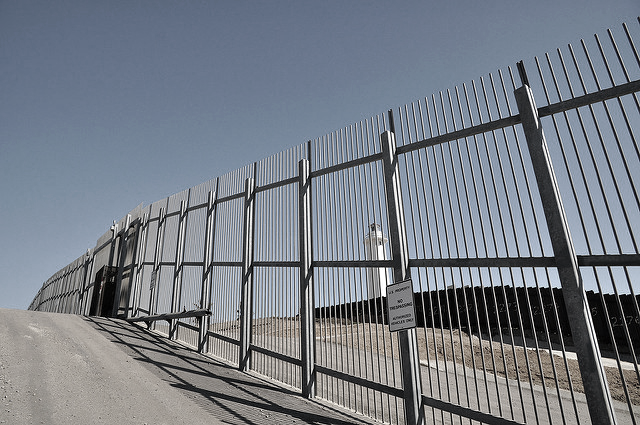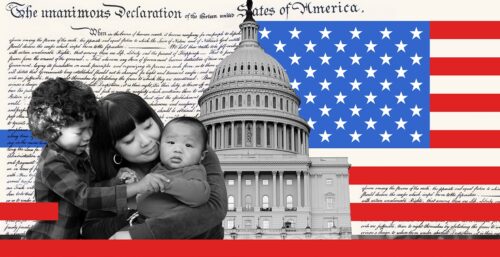On January 25, 2017, President Trump signed an executive order, “Border Security and Immigration Enforcement Improvements,” which includes costly plans to further militarize the U.S.-Mexico border, curtail due process, and expand problematic detention and enforcement practices. The order will likely result in asylum seekers, families, children, and others being turned away and denied access to humanitarian protection guaranteed for decades under U.S. and international law.
The order demands the construction of a contiguous wall along the nearly 2,000-mile southern border; provides additional resources to Border Patrol agents; drastically increases detention along and beyond the southern border; expands the use of expedited removal to the entire nation while limiting the use of discretion in deciding whom to deport; and outlines enforcement changes, including authorizing more state and local officials to enforce federal immigration laws.
Overall, the provisions in the order pose serious concerns for the protection and due process rights of those currently residing in the United States, communities along the U.S-Mexico border, and vulnerable populations seeking protection in the country. Additionally, the order would require tremendous additional funding that would increase the country’s record-level spending on existing border security and interior enforcement measures.
Construct an “Impassable” Southern Border
The executive order directs the Department of Homeland Security (DHS) to take immediate steps to allocate available funds to build a contiguous, physical wall on the U.S.-Mexico border and to create a long-term funding plan for the wall. It also calls for more resources to be allocated to U.S. Customs and Border Protection (CBP), including the hiring of 5,000 additional agents.
Adding to the existing border fencing is superfluous and wasteful. As of early 2017, approximately 650 miles of border fence are already in place, including:
- 350 miles of primary pedestrian fencing;
- 300 miles of vehicle fencing;
- 36 miles of secondary fencing behind the primary fencing; and
- 14 miles of tertiary pedestrian fencing behind the secondary fence.
The estimated average cost of the remaining segments of the border wall ranges from $15 to $25 billion, with each mile of fencing costing $16 million. The head of the National Border Patrol Council, a union representing 16,000 Border Patrol agents which endorsed President Trump during his campaign, said, “We do not need a wall along the entire 2,000 miles of border.”
In order to build the wall, Congress will have to appropriate significant additional funding. It is unclear if Congress is willing to spend many billions of dollars or incur the additional yearly costs for fence maintenance and upkeep.
Increase the Use of Detention at the Border and in the Interior
The order, if funded, will massively expand the use of detention. Individuals merely suspected of violating immigration law can now be apprehended and detained, pending further proceedings, according to the administration’s policy announced in the order.
In addition, the order directs DHS to detain all individuals in removal proceedings to the maximum extent of the law, regardless of whether they are merely awaiting their court hearing or have a final order of deportation. It also directs the termination of “catch and release.” This term refers to the practice of releasing non-Mexican migrants from detention while they await their removal hearings, which, contrary to the language in the order, DHS ended in 2006.
This dramatic shift in the use of detention would impose tremendous due process and humanitarian costs on immigrant families and communities, not only at the border, but throughout the country. Detained immigrants are the least likely to have counsel to help them navigate the immigration court system; from 2007-2012, only 14 percent of detainees acquired legal counsel, compared to two-thirds of non-detained immigrants.
Expand Detention Capacity
The order further directs DHS to immediately construct detention facilities along the southern border, where asylum officers and immigration judges will be assigned to conduct interviews and removal proceedings. The expanded use of mandatory detention as described in the order is not feasible with the current number of detention beds. Congress has directed ICE to maintain 34,000 detention beds and appropriated funds to pay for them. Yet, as of the fall of 2016, ICE was far over capacity, with more than 40,000 people in immigration detention.
Construction and maintenance costs for new detention facilities would be exorbitant; spending on ICE’s 34,000 detention beds costs taxpayers over $2 billion each year. Since the federal government is operating under a Fiscal Year (FY) 2016 continuing resolution until April 28, 2017, it is doubtful that sufficient funds currently exist to implement these plans.
Moreover, additional funds would likely be needed in order to assign asylum officers and immigration judges to more detention facilities. Yet, there is already a shortage of officers and judges in the country. The Executive Office for Immigration Review has been unable to hire the number of immigration judges that Congress appropriated funding for in FY 2017. It is unclear whether asylum officers or immigration judges would be deemed exempt from a January 23, 2017, executive memorandum authorizing a government-wide hiring freeze.
Expand Expedited Removal
The order directs DHS to dramatically expand the use of “expedited removal,” a process that permits immigration officers to quickly deport certain noncitizens without seeing an immigration judge often in as little as 24 hours.
The order could permit immigration officers to apply expedited removal throughout the country to all individuals who unlawfully entered the United States and cannot prove to DHS that they have been continuously present for the previous two years. Prior policies limited the use of expedited removal to border regions (broadly defined as within 100 miles of any U.S. border) and to individuals who were apprehended within 14 days of entry to the United States.
Once implemented, the order will eviscerate due process for large numbers of undocumented individuals in the United States, even those with family ties and deep roots in our communities, like Dreamers. The United States Commission on International and Religious Freedom—an independent, bipartisan federal commission—extensively documented how expedited removal sends many asylum seekers back into danger without a meaningful chance to present their claim to a judge.
Local Law Enforcement Acting as Immigration Officials under the 287(g) Program
The order also directs the Secretary of Homeland Security to increase the number of 287(g) agreements¾a program where DHS deputizes select state and local law enforcement officers to perform the functions of federal immigration agents under Section 287(g) of the Immigration and Nationality Act. Deputized officers are authorized to interview individuals to determine their immigration status; check DHS databases for information on individuals; issue ICE “detainers” to hold them until ICE takes custody; and issue a Notice to Appear (NTA), the official charging document that begins the immigration court removal process.
Problems with the 287(g) program are well-documented. A March 2010 report by the DHS Office of Inspector General (OIG) found, among other things, that ICE and its local law enforcement partners had not complied with the terms of their 287(g) agreements; that the evaluation parameters for deputized officers contradicted the stated objectives of the program; and that the program was poorly supervised by ICE and needed additional oversight. Under the Obama administration, the program was significantly reduced and ended agreements that had allowed deputized officers to interrogate and arrest alleged noncitizens encountered in the field who they believe violated federal immigration laws. In other words, agreements could only deputize officials to act as immigration officials in jails rather than in the field.
The executive order directs DHS to establish more agreements that are structured to maximize the enforcement of federal immigration laws, but it is unclear what other changes may be involved. The 287(g) expansion will require additional funds from Congress to pay for local law enforcement training and ICE supervision of the program.
Conduct Removal Proceedings Outside of the U.S.
The order instructs DHS to ensure that applicants for admission arriving on land from Mexico and Canada are returned to the country from which they approached the United States, pending a formal removal proceeding. In order to do this, there will presumably need to be cooperation from Mexico and Canada. It is unclear how exactly this would be implemented, but the possibility raises significant due process concerns.
Limit Humanitarian Protection
The order targets two important statutory mechanisms for protecting vulnerable immigrants: (1) “parole” (by which DHS can allow an individual to enter or stay in the country, or be released from detention for urgent humanitarian reasons or significant public benefit), and (2) “credible fear” screenings for asylum seekers.
The order requires DHS to ensure that these protections are not “exploited” to allow individuals who are otherwise removable to remain in the United States. DHS’ statutory parole authority is broad, and has been used in the past on a case-by-case basis to keep families together, especially military families. A policy change in this area could have devastating implications for close family members of U.S. soldiers. In addition, heightening the credible fear standard would make it even harder for asylum seekers with genuine claims under U.S. law to ever have the opportunity to present those claims to a judge.
Prioritize Criminal Prosecution of Unlawful Entry
The order directs the Attorney General to prioritize the prosecution of any offense connected to the southern border—including nonviolent offenses like unlawful entry. This would further militarize border communities and take limited U.S. attorney resources away from prosecuting other types of crimes—including violent crimes—thereby reducing public safety. In FY 2016, these immigration-related prosecutions already represented 52 percent of the total federal court docket.




